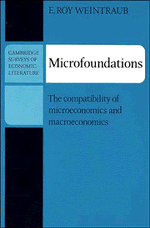Summary
To many economists there is a clear interrelationship between microeconomics and macroeconomics. If asked by a student to explain how micro profit maximization constrains a macromodel, the economist might describe aggregate supply as an aggregate production function, and the demand for labor as a derived demand which, under competitive profit maximization conditions, can be set equal to the real wage rate. If asked about the relation between the theory of consumer behaviour and the theory of the consumption function, the economist may produce a sophisticated utility maximization framework. Constraints involve income and wealth such that, for given tastes and prices, real consumption demand depends on real disposable income appropriately defined.
The microeconomic foundations of the aggregate demand for money can be similarly located in choice-theoretic portfolio analysis or inventory analysis. The demand for capital goods may be studied as part of firms' desires to maximize discounted net worth.
If the student wished to press further, there is a set of questions which could be developed at a higher level of abstraction. “How,” it might be asked, “is it possible to generate labor market excess supply in equilibrium, when in microeconomics we were taught that excess demand was zero in equilibrium?” The standard answers here probably vary with the training of the instructor, but most economists would describe the difference between partial equilibrium analysis and general equilibrium theory, and suggest that in a multi-market framework, disturbances or structural rigidities in one market may induce disequilibrium in another market.
- Type
- Chapter
- Information
- MicrofoundationsThe Compatibility of Microeconomics and Macroeconomics, pp. 3 - 18Publisher: Cambridge University PressPrint publication year: 1979



